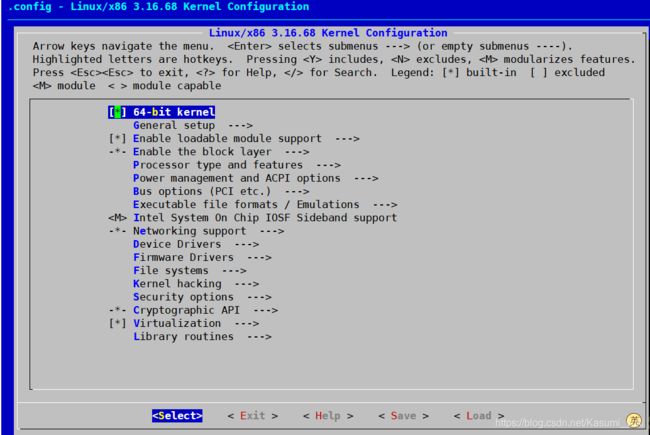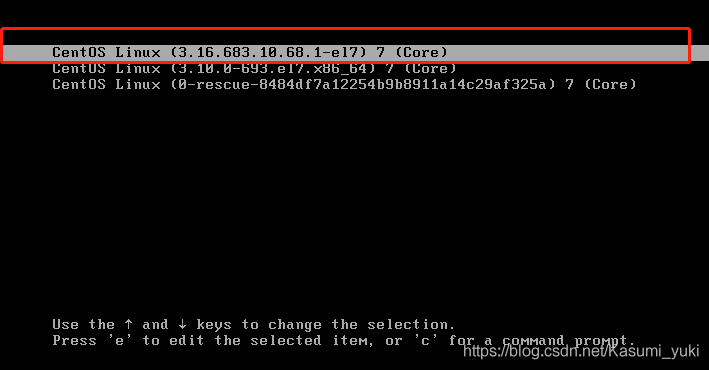编译内核(测试)
一.编译内核
1.相关准备
1.准备相关的开发环境
1)Centos6.9
[root@grub6 ~]# yum groupinstall "Development Tools" 安装开发工具包组
[root@grub6 ~]# yum groupinstall "Server Platform Development " 安装服务开发平台包组
[root@grub6 ~]# yum install ncurses-devel 安装ncurses-devel包
ps:若未安装ncurses-devel包,后面无法使用make menuconfig
2)Centos7.4
[root@yuki ~]# yum groupinstall "Development Tools" 安装开发工具包组
ps:centos7中发现服务开发平台包组已经没有了,并且安装Development Tools发生报错,显示没有没有安装组文件,使用如下方法解决
[root@yuki ~]# yum groups mark install "Development Tools"
[root@yuki ~]# yum groups mark convert "Development Tools"
[root@yuki ~]# yum groupinstall "Development Tools"
2.获取目标主机上硬件设备的相关信息:
1)获取CPU信息:
1.cat /proc/cpuinfo
2. lscpu
3. x86info -a
2)查看PCI设备:
1.lspci,支持-v,-vv选项
2.lsusb,支持-v,-vv选项
3.lsblk
4.hal-device 了解全部硬件设备的信息,centos6上默认安装
2.内核编译的过程
2.1相关步骤
1.获取linux内核源码文件:www.kernel.org
[root@yuki ~]# uname -r
3.10.0-693.el7.x86_64
[root@yuki ~]# ll linux-3.16.68.tar.xz
-rw-r--r--. 1 root root 73304476 5月 26 01:16 linux-3.10.67.tar.xz
2.解压缩源代码文件到指定目录:/usr/src
[root@yuki ~]# tar -xf linux-3.16.68.tar.xz -C /usr/src/
3.软链接解压后的文件
[root@yuki src]# cd /usr/src/
[root@yuki src]# ls
debug kernels linux linux-3.16.68
[root@yuki src]# ln -sv linux-3.16.68 linux
"linux" -> "linux-3.16.68"
[root@yuki src]# ls
debug kernels linux linux-3.16.68
4.复制当前系统内核的配位模板文件到新内核目录下面
[root@yuki src]# cd linux
[root@yuki linux]# cp /boot/config-3.10.0-693.el7.x86_64 ./.config
cp:是否覆盖"./.config"? y
[root@yuki linux]# ls ./.config
./.config
5.配置内核选项
1)支持“更新”模式进行配置,在已有的.config文件的基础上进行“修改”配置
1.make config:基于命令行遍历的方式去配置内核中可配置的每个选项
2."make menuconfig:基于cureses的文本配置窗口" 一般使用此选项即可
3.make gconfig:基于GTK开发环境的窗口使用,对应包组为“桌面平台开发”
4.make xonfig:基于QT开发环境的窗口界面
ps:使用make menuconfig进入如下界面,进行相应配置,此次测试设定的local version为3.16.683.10.68.1-el7
[root@yuki linux]# make menuconfig
2)支持“全新配置”模式进行配置
1.make defconfig:基于内核为目标平台提供的“默认配置为模板进行配置”
2.make allnoconfig:所有选项都为No,可用于个性化定制
6.编译内核:make [-j #],可使用-j指定编译线程数量
进入screen后让其自动编译
[root@yuki linux]# screen
[root@yuki linux]# make -j 4
[detached from 9273.pts-0.yuki]
ps:为防止出现终端机网络波动出现掉线,导致编译内核被终止,一般使用screen命令
screen命令
1.打开screen:screen
2.拆除screen:ctrl+a,之后按d
3.列出当前screen:screen ls
4.连接至screen:screen -r SCREEN_ID
5.关闭screen:exit
7.安装内核模块,此时已经能够看到编译好的模块
[root@yuki ~]# make modules_install
[root@yuki ~]# cat /proc/sys/kernel/hostname
yuki
[root@yuki ~]# ls /lib/modules
3.10.0-693.el7.x86_64 3.16.683.10.68.1-el7
[root@yuki ~]# ls /lib/modules/3.16.683.10.68.1-el7/
build modules.alias.bin modules.dep modules.order modules.symbols.bin
kernel modules.builtin modules.dep.bin modules.softdep source
modules.alias modules.builtin.bin modules.devname modules.symbols
8.安装内核,已经能够看到对应的vmlinuz,initramfs..
[root@yuki ~]# make install
[root@yuki ~]# ls /boot
config-3.10.0-693.el7.x86_64
efi
grub
grub2
initramfs-0-rescue-8484df7a12254b9b8911a14c29af325a.img
initramfs-3.10.0-693.el7.x86_64.img
initramfs-3.16.683.10.68.1-el7.img
initrd-plymouth.img
symvers-3.10.0-693.el7.x86_64.gz
System.map
System.map-3.10.0-693.el7.x86_64
System.map-3.16.683.10.68.1-el7
vmlinuz
vmlinuz-0-rescue-8484df7a12254b9b8911a14c29af325a
vmlinuz-3.10.0-693.el7.x86_64
vmlinuz-3.16.683.10.68.1-el7
9.重启系统,此时已经能看到刚编译过的内核,选择使用新内核
[root@yuki ~]# vim /etc/grub2.cfg grub2的配置文件
[root@yuki ~]# vim /etc/default/grub 设置默认选项
[root@yuki ~]# uname -r
3.16.683.10.68.1-el7
3.编译补充说明
3.1编译
1.多线程编译:make [-j #]
2.编译内核中的一部分代码
1)只编译某子目录中的相关代码
1.cd /usr/src/linux
2.make path/to/dir/
2)只编译一个特定的模块
1.cd /usr/src/linux
2.make path/to/dir/file.lo
3)实现交叉编译
目标平台与当前编译操作所在不同平台
make ARCH=arch_name
要获取特定目标平台的使用帮助
make ARCH=arch_name help
3.2重新编译
1.在执行过编译操作的内核源码树上做重新编译
2.事先清理操作
1)make clean:清理编译生成的绝大多数文件,但会保留config,及编译外部模块所需要的文件
2)make mrproper:清理编译生成的所有文件,包括配置生成的config文件及某些备份文件
3)make distclean:相当于mrproper,额外清理各种patches以及编辑器备份文件

